Plus Two Botany Notes Chapter 6 Organisms and Populations is part of Plus Two Botany Notes. Here we have given Plus Two Botany Notes Chapter 6 Organisms and Populations.
| Board | SCERT, Kerala |
| Text Book | NCERT Based |
| Class | Plus Two |
| Subject | Botany Notes |
| Chapter | Chapter 6 |
| Chapter Name | Organisms and Populations |
| Category | Plus Two Kerala |
Kerala Plus Two Botany Notes Chapter 6 Organisms and Populations
Organism And Its Environment
| The annual variations in the intensity and duration of temperature, resulting in distinct seasons. These variations together with annual variation in precipitation (precipitation includes both rain and snow) responsible for the formation of major biomes such as desert, rain forest and tundra. |
Regional and local variations within each biome lead to the formation of a wide variety of habitats.
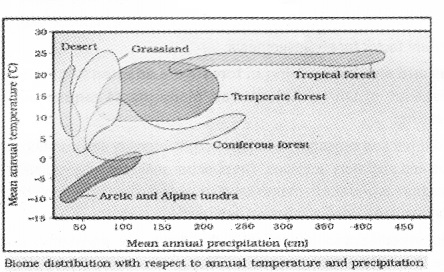

The existence of life not only in favourable habitat but it occurs in scorching Rajasthan desert, rain-soaked Meghalaya forests, deep ocean trenches, torrential streams, permafrost polar regions, high mountain tops, boiling thermal springs, and stinking compost pits.
1. Major Abiotic Factors:
Temperature:
The average temperature on land varies seasonally, it decreases from the equator towards the poles and from plains to the mountain tops. It ranges from minus degree Celsius in polar areas and high altitudes to more than 50°C in tropical deserts in summer.
It is clear that mango trees cannot grow in temperate countries like Canada and Germany, and the snow leopards are not found in Kerala forests.
Actually, temperature affects the kinetics of enzymes which influence the basal metabolism, activity and other physiological functions of the organism.
| A few organisms can tolerate and thrive in a wide range of temperatures they are called eurythermal, but majority of them are restricted to a narrow range of temperatures they are called stenothermal. |
Water:
The productivity and distribution of plants is dependent on water. For aquatic organisms the quality (chemical composition, pH) of water is important.
The salt concentration (salinity in parts per thousand), is less than 5 per cent in inland waters, 30 – 35 per cent the sea and > 100 per cent in some hypersaline lagoons.
| Some organisms can tolerate wide range of salinities, they are called euryhaline but others are restricted to a narrow range they are called stenohaline. |
Freshwater animals cannot live for long in seawater and vice versa because of the osmotic problems.
Light:
It is an important factor for photosynthesis.
Small plants (herbs and shrubs) growing in forests are adapted to photosynthesize under very low light conditions because of tall canopied trees. Many plants require sunlight for the initiation of photoperiodic flowering.
Animals require the diurnal and seasonal variations in light intensity and duration (photoperiod) fortiming their foraging, reproductive, and migratory activities. The spectral quality of solar radiation is important for life.
The UV component of the spectrum is harmful to many organisms while other colour components of the visible spectrum are important for marine plants living at different depths of the ocean.
Soil:
The nature and properties of soil dependent on the climate and the weathering process. The characteristics of the soil determine the water holding capacity.
These characteristics, pH, mineral composition, and topography determine the vegetation in any area. In the aquatic environment, the sediment-characteristics determine the type of benthic animals in ocean.
2. Responses to Abiotic Factors:
During the course of millions of years many species would have evolved constant internal (within the body) environment that permits maximum efficiency of biochemical reactions and physiological functions that results overall ‘fitness’ of the species.
| Some organism maintain the constant internal environment when the external environmental conditions changes it is called homeostasis. |
A person is able to do his/her work in temperature is 25°C when it is extremely hot or cold outside. It could be achieved at home, in the car while travelling, and at workplace by using an air conditioner in summer and heater in winter. Here the person’s homeostasis is maintained by artificial means.
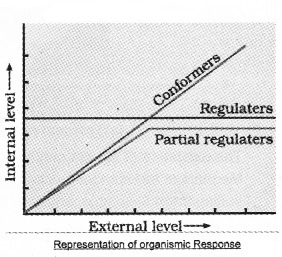
How do other living organisms cope with the situation?
(i) Regulate:
Some organisms maintain their homeostasis by keeping up constant body temperature, constant osmotic concentration, etc.
Birds, mammals, and some lower vertebrate and invertebrate species are capable of such regulation i.e thermoregulation and osmoregulation. This is the characteristics of mammals to live in Antarctica or in the Sahara desert.
In summer season body of man sweat, it provide cooling effect. In Winter season, vyhen the temperature is much lower than 37°C, man start to shiver, a kind of exercise which produces heat and raises the body temperature. Plants do not have such mechanisms to maintain internal temperatures.
(ii) Conform:
Majority of animals and all plants cannot maintain a constant internal environment.
| Thermoregulation is energetically expensive for many organisms. This is true for small animals like shrews and humming birds. Small animals have a larger surface area relative to their volume, they tend to lose body heat very fast when it is cold outside; so they have to spend much energy to generate body heat through metabolism. That is why very small animals are rarely found in polar regions. |
If the stressful external conditions are remain only for a short duration, the organism has two other alternatives.
(iii) Migrate:
The organism move temporarily from the stressful habitat to a more favourable area and return when stressful period is over. Some persons moving from Delhi to Shimla in summer season. During winter some birds from Siberia and other extremely cold northern regions migrate to Keolado National Park (Bhartpur) in Rajasthan.
(iv) Suspend:
In bacteria, fungi and lower plants produce thick walled spores during unfavourable Conditions. They germinate in suitable environment.
In higher plants the seeds and vegetative reproductive structures are dormant during adverse condition and germinate after getting favourable moisture and temperature.
In animals, especially bears go into hibernation during winter. Some snails and fish go into aestivation to avoid summer. Under unfavourable conditions many zooplankton species in lakes and ponds are subject to diapause, a stage of suspended development.
3. Adaptations:
Some organisms are subjected to physiological and behavioural adjustments. These responses are called adaptations Kangaroo rat in North American deserts is capable of meeting all its water requirements through its internal fat oxidation. It has the ability to concentrate its urine.
| Desert plants have a thick cuticle on their leaf surfaces and stomata arranged in deep pits to minimise water loss through transpiration. They also have CAM pathway in which they open stomata during night and closed during day time. |
Opuntia, their leaves are reduced to spines and the flattened stems do photosynthesis. Mammals of colder climates have shorter ears and limbs to minimise heat loss. This is an Allen’s Rule In the polar seas aquatic mammals like seals have a thick layer of fat (blubber) below their skin that acts as an insulator and reduces loss of body heat.
In high altitude, some organism feels altitude sicknes due to low atmospheric pressure and low 02. Its symptoms include nausea, fatigue, and heart diseases. But, gradually get adapted and stop experiencing altitude sickness by increasing red blood cell production, decreasing the binding capacity of hemoglobin and by increasing breathing rate.eg- Many tribes live in the high altitude of Himalayas.
Archaebacteria seen in hot springs and deep sea hydrothermal vents where temperature is more than 1000°C.
Many fish thrive in Antarctic waters where the temperature is below 0°c. A large variety of marine invertebrates and fish live at great depths in the ocean where the pressure could be > 100 times the normal atmospheric pressure.
Desert lizards keep their body temperature constant by behavioural means. They bask in the sun and absorb heat when their body temperature drops, but move into shade when the surrounding temperature starts increasing.
Some species are capable of burrowing into the soil to escape from the above-ground heat.
Populations
1. Population Attributes:
Population has birth rates and death rates. The rates are expressed as the change in numbers with respect to the members of the population. If in a pond there are 20 lotus plants last year and through reproduction 8 new plants are added, so the current population is 28, birth rate is 8/20 = 0.4 offspring per lotus per year.
If 4 individuals in a laboratory population of 40 fruit flies died in a week, the death rate in the population during that period is 4/40 = 0.1 individuals per fruit fly per week.
Another attribute of a population is sex ratio. A population at any given time is composed of individuals of different ages. If the age distribution is plotted for the population, the resulting structure is called an age pyramid.

The shape of the pyramid indicates the growth status of the population i.e
- growing,
- stable and
- declining.
Another important attribute of population is population Representation of age pyramids for human population density (designated as N) Total number is the measure of population density, it is difficult to determine if the counting is impossible.
In an area, if there are 200 Parthenium plants but only a single huge banyan tree with a large canopy, the population density of banyan is low when compared to that of Parthenium. In such cases, the per cent cover or biomass is the measure of the population size.
Number of fish caught pertrap is good measure of its total population density in the lake. The tiger census in our national parks and tiger reserves is based on pug marks and fecai pellets.
2. Population Growth:
Changes in population density that determined by four basic processes, natality, immigration mortality, and emigration.
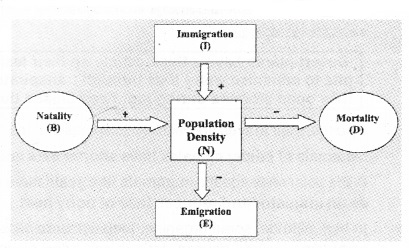
- Natality refers to the number of births during a given period
- Mortality is the number of deaths in the population during a given period.
- Immigration is the movement of individuals into the population
- Emigration is the movement of individuals out of the population.
N is the population density at time t, then its density at time t + 1 is
Nt + 1 =Nt + [(B + I) – (D + E)]
Population density increase if the number of births plus the number of immigrants (B + I) is more than the number of deaths plus the number of emigrants (D + E).
If a new habitat is just being colonised, immigration contribute to population growth than birth rates.
Growth Models:
(i) Exponential growth:
When the resources in the habitat are unlimited, each species has the ability to grow in number. Here the population grows in an exponential or geometric fashion.

Population growth curve a when responses are not limiting the growth, plot Is exponential, b when responses are limiting the growth, plot is logistic, K ts carrying capacity
If in a population of size N, the birth rates are represented as b and death rates as d, then the increase or decrease in N during a unit time period t (dN/dt) will be
| dN/dt = (b – d) × N (b – d) = r, then dN/dt = rN |
r is called the ‘intrinsic rate of natural increase’it is important for assessing impacts of any biotic or abiotic factor on population growth.
The above equation shows the exponential or geometric growth and results J-shaped curve The integral form of the exponential growth equation as
![]()
Nt = Population density after time t, N0 = Population density at time zero, r = intrinsic rate of natural increase, e = the base of natural logarithms (2.71828).
(ii) Logistic growth:
Limited resources leads to competition between individuals and the ‘fittest’ individual will survive and reproduce. Governments of many countries introduced restraints to limit human population growth.
In nature, a given habitat has resources to support a maximum possible number, beyond which no further growth is possible. This is called as nature’s carrying capacity (K) for that species in that habitat.
So the population growth in limited resources show initially a lag phase, followed by phases of acceleration and deceleration and finally an stationary phase, and the population density reaches the carrying capacity.
A plot of N in relation to time (t) results in a sigmoid curve. This type of population growth is called Verhulst-Pearl Logistic Growth equation. It is represented by
dN/dt = rN(K−N)K
Where N = Population density at time t
r = Intrinsic rate of natural increase
K= Carrying capacity
3. Life History Variation:
Populations evolve to maximise their reproductive fitness, called as Darwinian fitness. Some organisms breed only once in their lifetime (Pacific salmon fish, bamboo) while others breed many times during their lifetime (most birds and mammals). Some produce a large number of small-sized offspring (Oysters, pelagic fishes) while others produce a small number of large-sized offspring (birds, mammals).
4. Population Interactions:
It occurs between species. Interspecific interactions arise from the interaction of populations of two different species. It is beneficial, detrimental or neutral (neither harm nor benefit) to one of the species or both. Assigning a ‘+’sign for beneficial interaction, sign for detrimental and 0 for neutral interaction,
Population Interactions
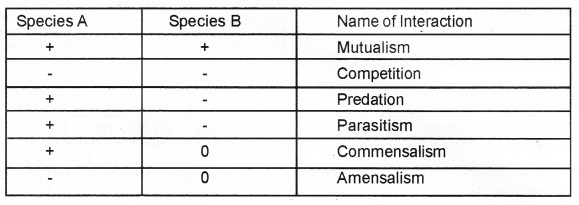
Both the species benefit in mutualism and both lose in competition. In both parasitism and Predation one species is benifitted and the other is harmed (host and prey).
In commensalism one species is benefitted and the other is neither benefitted nor harmed. In amensalism one species is harmed whereas the other is unaffected.
(i) Predation:
In predation, the energy stored at consumer level from plants are transferred to the next. So the consumer level energy transfer mainly takes place from prey to predator. For example prey is deer and predator is tiger.
The introduction of prickly pear cactus into Australia causes the spreading of these plants into millions of hectares. Later the cactus was controlled by cactus-feeding predator (a moth) from its natural habitat. This is an example of Biological control methods.
Predators also help in maintaining species diversity in a community, by reducing the intensity of competition among competing prey species. In the American Pacific Coast, the starfish Pisaster is an important predator.
In a field experiment, when all the starfish were removed from intertidal area, more than 10 species of invertebrates became extinct within a year, because of interspecific competition.
If a predator overexploits its prey, it become extinct. Later predator become extinct for the lack of food. This is the reason why predators in nature are ‘prudent’.
Prey species also have defense mechanism to reduce the impact of predation. Some species of insects and frogs are cryptically-coloured (camouflaged) so the prey cannot be detected easily by the predator. If the prey is poisonous, it cannot be attacked by the predators. Eg- Monarch butterfly is distasteful to its predator (bird).
Plants have evolved some morphological and chemical defences against herbivores. Thorns (Acacia, Cactus) are morphological defence. Many plants produce and store chemicals that affect the herbivores digestion, reproduction and finally kill it.
The weed Calotropis produces poisonous cardiac glycosides and that affect cattle or goats browsing on this plant. Chemical substances that extract from plants (nicotine, caffeine, quinine, strychnine, opium, etc.,) are defences against grazers and browsers.
(ii) Competition:
The competition mainly for resources that takesplace among same species and different species. For example flamingoes coming into shallow South American lakes compete with resident fishes for their common food, the zooplankton in the lake.
In interference competition, the feeding efficiency of one species is reduced due to other species, even if resources (food and space) are abundant. So, in competition the fitness of one species is lower in the presence of another species.
According to Gause, when resources are limiting the competitively superior species eliminate the other species, This is an example of competitive exclusion.
When the goats introduced in the Galapagos island, Abingdon tortoise become extinct due to the greater browsing efficiency of the goats.
Another evidence of competition in nature is called ‘competitive release’. Some species restricted to small geographical area because of the presence of a competitively superior species.
Connell’s elegant field experiments showed that on the rocky sea coasts of Scotland, the larger and competitively superior barnacle Balanus dominates the intertidal area, and eliminates the smaller barnacle Chathamalus.
Actually the herbivores and plants are more adversely affected by competition than carnivores.
Gause’s Competitive Exclusion Principle’ states that two closely related species competing for the same resources cannot co-exist, as a result competitively inferior one is eliminated.
Some species shows ‘resource partitioning’.that is, if two species compete for the same resource, they avoid competition by choosing different times for feeding or different foraging patterns.
MacArthur showed that five closely related species of warblers living on the same tree were able to avoid competition and co-exist due to behavioural differences in their foraging activities.
(iii) Parasitism:
Many parasites are host-specific. Some parasites evolved special adaptations such as the
| loss of unnecessary sense organs, presence of suckers to cling on to the host, loss of digestive system and high reproductive capacity. |
The life cycles of parasites consist of one ortwo intermediate hosts or vectors to facilitate parasitisation. The human liver fluke depends on two intermediate hosts to complete its life cycle. The malarial parasite needs a vector (mosquito) to cause disease in other hosts.
Majority of the parasites reduce the survival, growth and reproduction of the host and reduce its population density.
| Parasites that feed on the external surface of the host organism are called ectoparasites. Examples are the lice on humans and ticks on dogs. Ectoparasite copepods affect many marine fishes Chlorophyll-less Cuscuta a parasitic plant that absorbs nutritive materials from the host plant. Endoparasites that live inside the host body at different sites (liver, kidney, lungs, red blood cells, etc.). The life cycles of endoparasites are more complex. Their reproductive potential is more but their morphological and anatomical features are simple. |
In Brood parasitism parasitic bird lays its eggs in the nest of its host and the host incubate them. The eggs of the parasitic bird resemble the host’s egg in size Examples of brood parasitism are cuckoo (koel) and the crow.
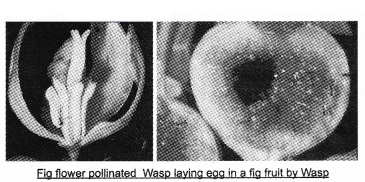
(iv) Commensalism:
This is the interaction in which one species benefits and the other is neither harmed nor benefited. An epiphytic orchid on a mango branch, and barnacles growing on the back of a whale get benefit. But the mango tree and the whale is neither harmed nor benefited.
The cattle egret and grazing cattle is an example of commensalism. Another example of commensalism is the interaction between sea anemone with stinging tentacles and the clown fish.
(v) Mutualism:
In this interaction both partner species are benefitted. Examples are Lichens (between a fungus and algae), mycorrhizae (between fungi and the roots of higher plants). The fungi help the plant in the absorption of essential nutrients from the soil while the plant in turn provides the energy-yielding carbohydrates.
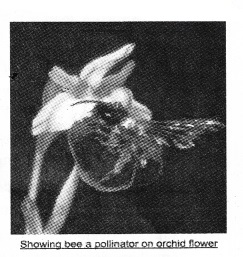
Some examples of mutualism are found in plant-animal relationships. Plants need animals for pollinating their flowers and dispersing their seeds. Plants offer rewards in the form of pollen and nectar for pollinators and juicy and nutritious fruits for seed dispersers.
| Co-evolution occurs between the flower and its pollinator species. In many species of fig trees, pollination is done by wasp. The female wasp uses the fruit not only for egg laying but uses the developing seeds within the fruit for nourishing its larvae. |
The Mediterranean orchid- Ophrys. petal of its flower shows the similarity with female bee in size, colour and markings. The male bee is attracted and ‘pseudocopulates’ with the flower, When this same bee pseudocopulates’ with another flower, it transfers pollen to it and thus, pollinates the flower.
We hope the Plus Two Botany Notes Chapter 6 Organisms and Populations help you. If you have any query regarding Plus Two Botany Notes Chapter 6 Organisms and Populations, drop a comment below and we will get back to you at the earliest.
